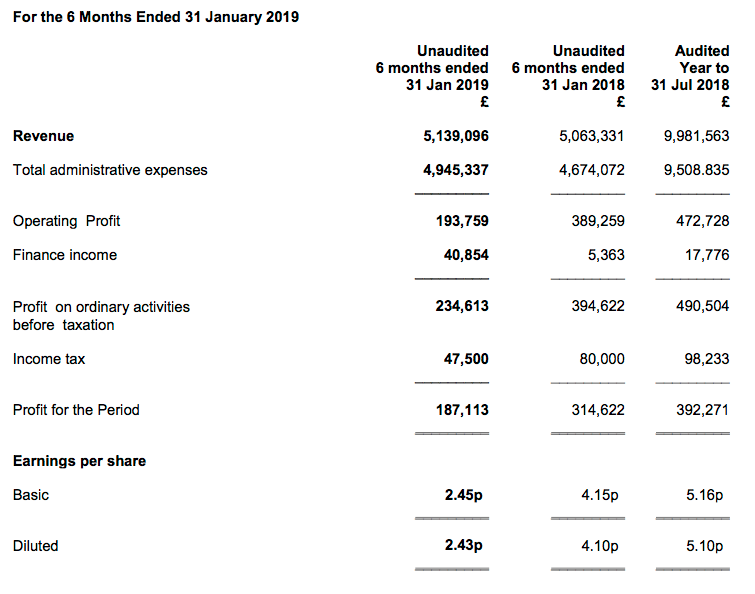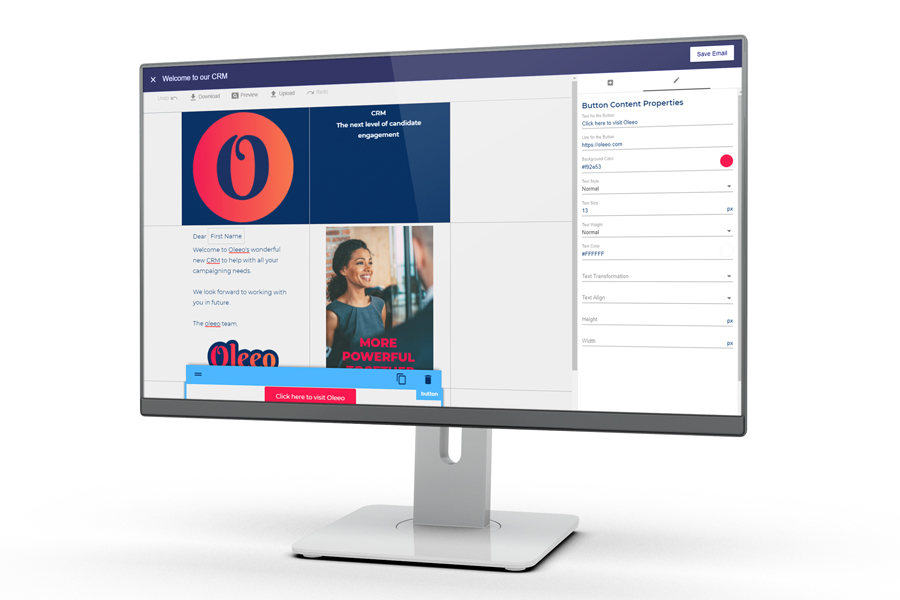07 May 2019
By Maynard Paton
Results verdict on Oleeo (OLEE):
- A terse 155-word statement revealed an unsurprising 50% profit plunge as OLEE extends its “capacity to suffer” to four years.
- At least revenue continues to inch ahead and might even be growing at a reasonable pace if the largest customer is excluded.
- Recent client installations include all four Welsh police forces — cementing OLEE’s 50%-plus share of supplying UK police recruitment IT.
- A lack of guidance for the full-year could strangely mark the low point for earnings.
- A £13m market cap is almost entirely supported by the £11m net cash position. I continue to hold.
Contents
Event link and share data
Why I own OLEE
Results summary
Revenue and profit
Financials
Valuation
Event link and share data
Event: Interim results for the six months to 31 January 2019 published 30 April 2019
Price: 170p
Shares in issue: 7,628,054
Market capitalisation: £12.9m
Why I own OLEE

- Develops recruitment software with an emphasis on customer support that has landed blue-chip clients such as Marks & Spencer, WPP, Morgan Stanley and 50%-plus of UK police forces.
- Founder/executive chairman enjoys 71%/£9m shareholding, ought to ensure long-term management consistency and may have the “capacity to suffer” to deliver long-term returns.
- A £13m market cap could be very inexpensive given the £11m net cash position and any forthcoming improvement to current minimal earnings.
Further reading: My OLEE Buy report | All my OLEE posts | OLEE website
Results summary

Revenue and profit
- Oleeo took the maximum three months (AIM Rule 18) to publish these results and a terse 155-word management narrative.
- November’s annual statement had already warned shareholders to expect profit to be “substantially lower in the current year”.
- Revenue gained 1% while operating profit dived 50%:
| H1 2017 | H2 2017 | H1 2018 | H2 2018 | H1 2019 | |||
| Revenue (£k) | 5,104 | 4,744 | 5,063 | 4,918 | 5,139 | ||
| Costs (£k) | (4,434) | (4,642) | (4,674) | (4,835) | (4,945) | ||
| Operating profit (£k) | 670 | 102 | 389 | 83 | 194 |
- Revenue set a new first-half record and management “expected to see some improvement in sales during the second half”.
- Turnover for the full year is therefore very likely to top £10m for the first time.
- Total revenue progress could have been hindered by lower income from HRMC, Oleeo’s largest customer.
- The 2018 annual report (point 3) revealed sales excluding the group’s largest customer gained 6% last year (versus a 1% overall advance).
- A contract with Welsh police forces and the introduction of product algorithms may have enhanced revenue during the half year.

- The £194k operating profit for the half compares relatively well to the £83k profit registered during the preceding second half.
- During 2012, 2013 and 2014, first-half operating profit actually surpassed £1m.
- Subsequent heavy expenditure to bolster products, marketing and staff has since depressed earnings to minimal levels.
- Optimistic shareholders may view this investment phase as management’s “capacity to suffer” — a tolerance of significant expenditure with no near-term return but the potential for high long-term rewards.
- OLEE has not said when the current rate of expenditure will recede (if ever).
- A possible straw to clutch: OLEE did not provide any guidance (woeful or otherwise) for the full year.
- In contrast, the previous four results statements issued the following gloomy forecasts:
- November 2018: “…a highly challenging and uncertain outlook for sales and, more particularly, profits, which are expected to be substantially lower in the current year than in the year which has just closed”.
- April 2018: “[W]e expect profits for the second half of the year to be lower than the first half and for this to be reflected in a lower profit for the full year than we achieved in 2017”.
- November 2017: “[W]e expect to see a further significant fall in profits.”
- April 2017: “I expect the profit for the full year to be significantly reduced compared to last year and for our investments to have a material adverse impact on our results for 2018.”
- The absence of further bad news this time around could mean the £83k generated during the preceding second-half marked the low point for profit.
- The 2018 annual report revealed the board taking a pay cut (point 4). I wrote at the time: “Wishful thinking perhaps, but I would like to think when directors cut their own pay, a greater focus is soon applied to lifting sales and profit.”
Enjoy my blog posts through an occasional email newsletter. Click here for details.
Financials
- OLEE’s accounts are still in acceptable shape.
- Cash in the bank remains the leading attraction at £10.9m or 143p per share.
- The balance sheet carries no debt and no pension complications.
- Cash flow consumed £115k during the six months, due entirely to working-capital movements that are typically reversed during the second half.
- Margins, return on equity and other ratios remain at pitiful levels due to the depressed level of profit.
- All development expenditure is expensed as incurred and not capitalised onto the balance sheet (other software companies should take note).
- Finance income during the half came to £41k — a significant 17% of pre-tax profit.
- The 2018 annual report (point 6) showed OLEE utilising short-term deposit accounts earning between 0.75% and 1% for part of the company’s cash position.

Valuation
- OLEE remains a tightly held share with a minimal free float and wide bid-offer spread.
- The executive chairman owns 71%, his wider family control 13% and a managed fund holds 9%.
- Everyone else therefore owns 8%.
- A 170p offer price values OLEE at £13m and the free float at £1m.
- Subtract the £10.9m cash position from the market cap and the underlying business could arguably be valued at approximately £2m.
- OLEE has always operated with significant net cash, and perhaps the presence of such cash is required to keep clients happy and therefore is not really ‘surplus to requirements’.
- OLEE reported earnings of £1.9m during 2014. A return to that level of profitability could make the present valuation very inexpensive.
- Mind you, OLEE’s shares have always seemed cheap.
- My initial investment was influenced by an apparent P/E of 7 — and the shares have halved since then.
- Earnings for 2015, 2016, 2017 and 2018 were lower than those reported for 2014.
- Profit retained by the business since 2014 has therefore not created any value to date.
- May be one day OLEE’s software products could re-exhibit the attractive returns of yesteryear — or at least something close to them.
- Between 2011 and 2014 for instance, the operating margin topped 21% and return on equity topped 23%.
- Shareholders can only hope OLEE’s significant expenditure since 2014 will eventually pay off.
- Shareholders have been waiting for four years now.
- OLEE has never declared an interim dividend. The annual payout is likely to remain at 3.5p per share for the fourteenth consecutive year.
- The yield at 170p is 2%.
Maynard Paton
PS: You can receive my blog posts through an occasional email newsletter. Click here for details.
Disclosure: Maynard owns shares in Oleeo.
